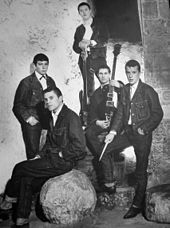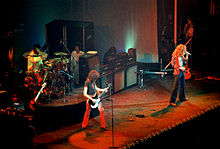British rhythm and blues
[2] However, vocalists such as Van Morrison, Mick Jagger, Eric Burdon and Steve Winwood did not attempt to emulate a particular singer and were seen by critics as able to sing the blues convincingly and with some power.
[1] Many groups were based around guitars (rhythm, lead and bass) and drums[5] and as a result arrangements tended to be guitar-oriented and at higher tempos than the originals.
[1] A unique form was pursued by Georgie Fame and the Blue Flames, who as the resident band at the Flamingo club on Wardour Street, unusual in having a predominantly black audience of American GIs and locals, also utilised jazz, but mixed R&B with elements of Caribbean music, including Ska and bluebeat.
He also brought over American folk and blues performers who found they were much better known and paid in Europe than America, a series of tours that began with Josh White and Big Bill Broonzy in 1951, and would include Brownie McGhee, Sonny Terry, Memphis Slim, Muddy Waters and Lonnie Johnson.
[17] In addition to members of the Beatles, a large number of British rhythm and blues musicians began their careers playing skiffle, including Van Morrison, Ronnie Wood, Mick Jagger and Roger Daltrey.
[18] The fashion created a demand for opportunities to play versions of American folk, blues and jazz music that would contribute to the growth of a club scene.
In 1964, for example, the song-catalogue of Lead Belly provided the Animals with "The House of the Rising Sun",[23] Manfred Mann with "John Hardy"[24] and the Four Pennies with "Black Girl".
Initially British audiences were shocked by Waters's amplified electric blues, but he was soon playing to ecstatic crowds and receiving rave reviews.
[30] As well as acting as a mentor to these figures and others, including John Mayall and Jimmy Page,[32] Korner was also a historian, writer and record collector pivotal in the growth of the movement, and often referred to as "the father of British blues".
[15] In 1964 the American Folk Blues and Gospel Caravan arrived in the UK for an 11-date tour, including in its line-up Sister Rosetta Tharpe, Blind Gary Davis, Sonny Terry, Muddy Waters and Otis Spann.
Howling Wolf's "Smokestack Lightning", released in the UK by Pye International Records that year, peaked at number 42 in the singles chart[44] and was covered by the Yardbirds, Manfred Mann, the Animals and the Who.
[48] Keith Richards and Mick Jagger, who had renewed their childhood association after discovering a shared interest in R&B records, were introduced to guitarist Brian Jones through Alexis Korner, after a Blues Incorporated gig at the Ealing Jazz Club.
[1] Other London-based bands that pursued a similar course to the Rolling Stones included the Yardbirds, the Kinks, the Downliners Sect, the Pretty Things, Gary Farr and the T-Bones and Pink Floyd.
They earned a formidable reputation as a live act, developing frantic improvised guitar–harmonica "rave-ups", but they enjoyed only modest success with singles based on R&B covers.
In 1965 they cut the more pop-oriented single "For Your Love", which made the top 10 in the UK and US, but the move away from the blues prompted Clapton to quit the band for a stint with John Mayall's Bluesbreakers and then to form Cream.
[55] The Pretty Things had UK hits with "Don't Bring Me Down" (1964) and the self penned "Honey I Need" (1965), which both reached the top twenty, but they failed to break into the American market and would be chiefly remembered for their later psychedelic work.
By the time they began to record they had already moved on to psychedelic compositions and jams that would make them a central feature of the emerging London Underground scene.
[57] Bands to emerge from other major British cities included the Animals from Newcastle, Them from Belfast and the Spencer Davis Group and the Moody Blues from Birmingham.
None of these bands played exclusively rhythm and blues, often relying on sources that included Brill Building and girl group songs for their hit singles, but it remained at the core of their early albums.
They moved to London in 1964 and released a series of successful singles, beginning with transatlantic hit "House of the Rising Sun", mixing more commercial folk and soul, while their albums were dominated by blues standards.
[59] The Spencer Davis Group had their first UK number one with the Jackie Edwards penned "Keep on Running" (1965), but became largely a vehicle for the young keyboard player and vocalist Steve Winwood, who at only 18 co-wrote "Gimme Some Lovin'" (1967) and "I'm a Man" (1967), both of which reached the Billboard 100 top 10 and became R&B standards.
[65] Zoot Money, whose Big Roll Band mixed R&B, soul, rock and roll and jazz, and was one of the most popular live acts of the era, made little impact in terms of record sales, but is noted for the later successes of its members, including guitarist Andy Summers, pianist Dave Greenslade, drummer Jon Hiseman, bassist Tony Reeves and saxophonist Clive Burrows.
They had a British hit with Etta James' R&B classic "I'd Rather Go Blind" in 1969, before Perfect left to join her husband John McVie in Fleetwood Mac, but remained largely focused on blues standards.
Vinegar Joe, formed in 1971 around the vocals of Elkie Brooks and Robert Palmer and the instrumental talents of Pete Gage and Steve York, despite popular stage performances, broke up after only three albums with disappointing sales two years later.
[88] London-based R&B pub rock bands received a major boost when the Jam kicked off the mod revival in 1977 with their debut album In the City, which mixed R&B standards with originals modelled on the Who's early singles.
[89] Pub rock bands like Red Beans and Rice, the Little Roosters, the Inmates, Nine Below Zero and Eddie and the Hot Rods, became major acts in the growing mod revival scene in London.
[92] Paul Weller broke up the Jam in 1982 and formed the Style Council, who abandoned most of the elements of punk to adopt music much more based in R&B and early soul.
[93] Some major figures of the movement, including Robert Palmer[94] and Steve Winwood, re-emerged as solo artists in the early 1980s, being as defined as blue-eyed soul singers.
[99] After leaving the Rolling Stones in 1997, Bill Wyman formed the Rhythm Kings, which featured guitarists Peter Frampton and Albert Lee as well former Procol Harum keyboardist Gary Brooker, touring and producing a series of R&B based albums.
[1] Many from the 60s helped pioneer psychedelic, and eventually progressive, hard rock and heavy metal, mixing in elements of world, folk and classical music.













